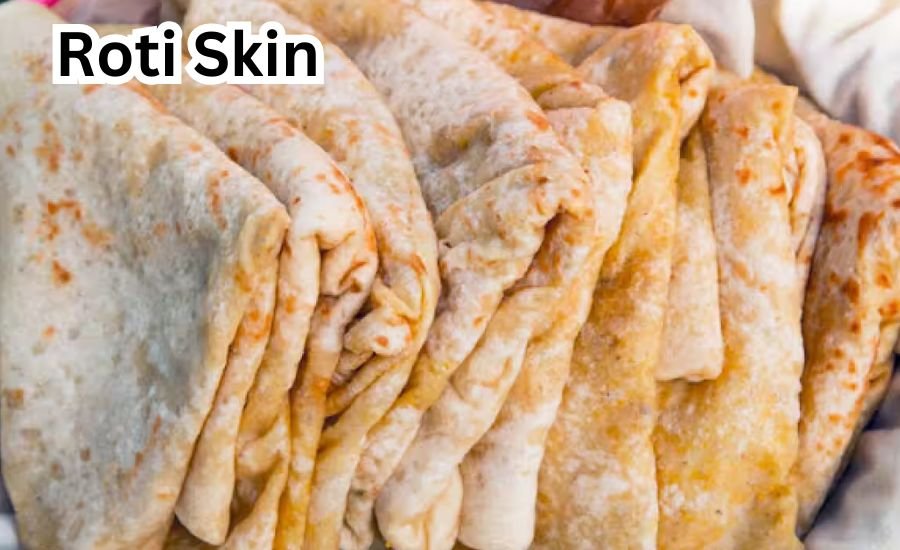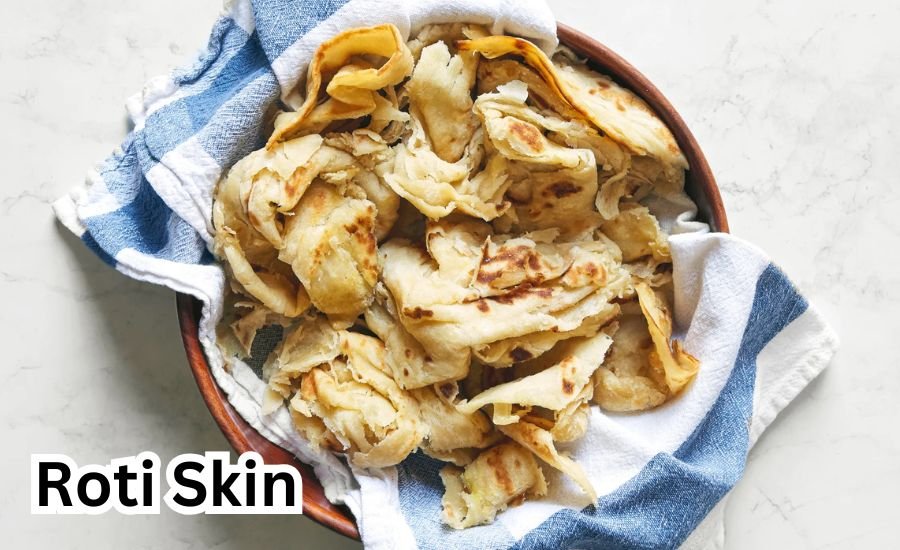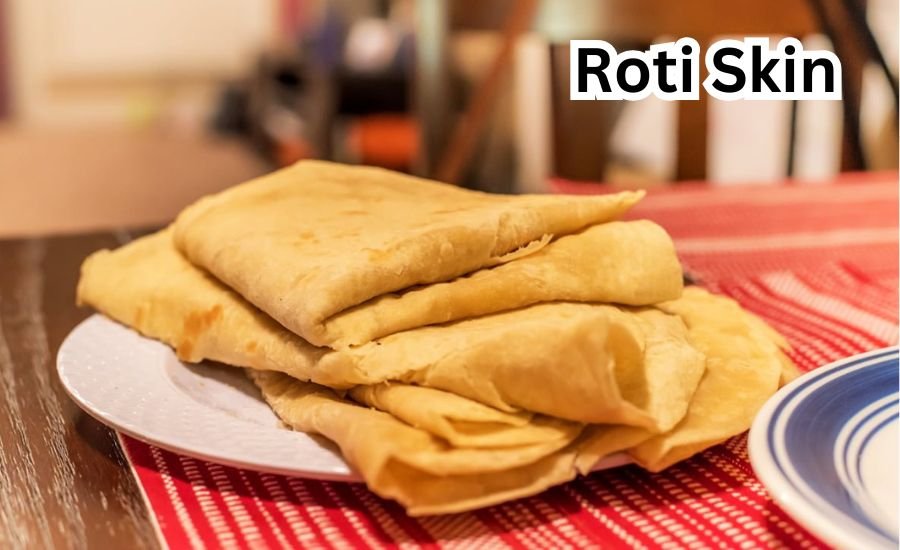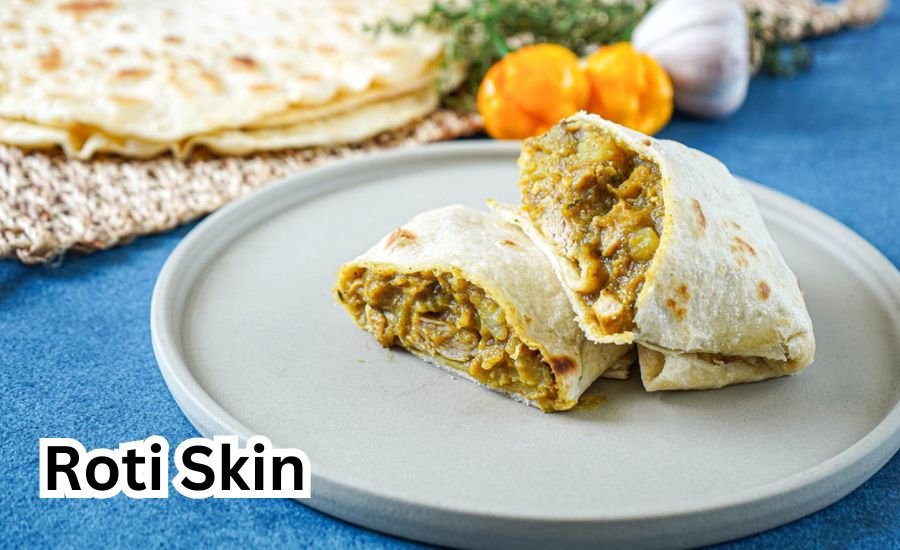Roti skin is a nutritious and often overlooked part of the traditional roti. Made from whole wheat flour, this outer layer is rich in fiber, vitamins, and minerals, making it an essential food for improving digestion and promoting overall health. It helps maintain a healthy gut, provides long-lasting energy, and supports weight loss efforts.
At Urban Insightz, we’re passionate about bringing you easy-to-understand health tips and nutrition advice. Our blog explores how everyday foods like it can play a key role in your wellness journey. Whether you’re looking to boost your skin health or improve digestion, it offers plenty of surprising benefits. Try adding it to your meals today for a natural, nutrient-packed boost!
What is Roti Skin? Understanding the Perfect Bite
Roti skin is the soft and chewy outer layer of a roti. It’s made from simple ingredients like flour, water, and sometimes a little salt. This delicious part of the roti is the reason why so many people love it with their meals. Whether you’re dipping it in curry or wrapping it around vegetables, it is a true comfort food for many.
When you make roti, the dough is rolled out flat and then cooked on a hot griddle. The heat makes the dough puff up, creating the soft and chewy texture we all enjoy. The roti skin gets its flavor from the cooking process, which gives it a slightly smoky and fresh taste. It’s not just food; it’s part of a tradition passed down through generations.
Roti skin is an essential part of many meals, especially in South Asian cuisine. It’s a great addition to various curries, stews, and even as a wrap for meats and vegetables. The soft texture makes it perfect for scooping up flavorful sauces, adding an extra layer of joy to every bite.
In many cultures, the making of it is a skill passed down from parents to children. Watching a parent roll the dough and cook the roti is a cherished memory for many. It’s more than just cooking; it’s about bonding, tradition, and sharing a meal that connects families together.
How to Make Soft and Delicious Roti Skin at Home
Making soft and delicious it at home is easier than it seems. All you need is flour, water, and a bit of salt. The first step is mixing the flour and water until you get a soft dough. After kneading it for a few minutes, you can divide the dough into small balls, ready to be rolled out.
To make perfect it, it’s important to roll out the dough evenly. Use a rolling pin to flatten each ball into a round shape. The thinner the dough, the softer and fluffier the roti will be. A hot, dry griddle or tawa is essential for cooking it.
When you place the rolled dough onto the griddle, you’ll notice it starts to bubble up. This is the key to getting a soft, fluffy texture. Flip it once the bubbles form, and cook for a few seconds on each side. If you like, you can press gently with a cloth or spatula to help it puff up even more.
To make sure your it stays soft, keep it covered with a cloth after cooking. This keeps the steam inside, keeping the roti fresh and warm for longer. Enjoy it with your favorite curry or stew, and you’ll have a delicious meal ready in no time!
Roti Skin vs. Naan: What’s the Difference?
Roti skin and naan are both flatbreads, but they’re quite different from each other. Roti skin is made with just flour, water, and salt, while naan usually has ingredients like yogurt, milk, and sometimes even sugar. These extra ingredients make naan softer and a bit thicker than it.
The texture of it is more chewy and lighter. It’s thin and perfect for scooping up curry or wrapping around ingredients. On the other hand, naan has a fluffier, bread-like consistency, making it a bit more filling. Naan also tends to be a bit more oily, which adds to its rich flavor.
Cooking methods also differ between the two. It is traditionally cooked on a flat griddle, while naan is often baked in a tandoor, a special clay oven. This difference in cooking methods gives naan a slightly smoky flavor and a different texture.
Both it and naan are delicious, but each one works better with certain dishes. Roti skin is great for lighter, saucier curries, while naan pairs well with dishes that are richer and heavier. Whether you choose it or naan depends on your personal taste and the type of meal you’re preparing.
The Secret to Perfect Roti Skin Every Time

Making perfect roti skin every time requires a little practice and the right technique. One key tip is to ensure the dough is soft and well-kneaded. If the dough is too stiff, your it will be hard and tough. It’s important to knead the dough for about 5-7 minutes to make sure it’s smooth and elastic.
Another secret to perfect it is rolling it out evenly. The thinner you roll the dough, the softer and fluffier your roti will be. If the dough is too thick, it may not puff up properly. It’s also important to make sure your griddle or tawa is hot enough. If it’s not hot enough, the roti won’t cook evenly.
When cooking the roti, watch for bubbles to form on the surface. This is a sign that it’s cooking properly. Flip the roti carefully and cook the other side until it’s golden brown. For an extra soft texture, you can press the roti with a cloth or spatula to help it puff up even more.
The key to perfect it is patience and attention to detail. With a little practice, you’ll be able to make it that’s soft, fluffy, and delicious every time. It’s all about getting the right consistency with the dough and the right temperature on the griddle.
Why Roti Skin Is Loved Around the World
Roti skin is loved around the world for its simplicity and versatility. People from different cultures enjoy roti as a side dish to their meals, from India to the Caribbean. Its soft texture and neutral flavor make it the perfect companion to a wide range of dishes, from spicy curries to stews.
What makes it so special is that it’s not just a food item; it’s a tradition. In many households, making roti is a family activity, passed down through generations. It’s a way for families to come together and share a meal. The process of rolling the dough and cooking the roti creates memories that last a lifetime.
Roti skin is also a symbol of comfort and warmth. When it’s freshly made, it’s soft, fluffy, and perfect for dipping into flavorful sauces. It’s a humble food that can be paired with almost anything, making it a beloved dish around the world.
Whether it’s served with curry, used to wrap meats, or enjoyed on its own, it is a versatile and comforting food. It brings people together, making every meal special and enjoyable.
How to Pair Roti Skin with Your Favorite Dishes
Roti skin is incredibly versatile and can be paired with many different dishes. It’s most commonly served alongside curries, where its soft texture is perfect for scooping up flavorful sauces. You can enjoy it with both vegetarian and non-vegetarian dishes, making it a great option for everyone.
One popular way to pair it is with a rich, spiced curry. Whether it’s a vegetable curry or a chicken curry, it complements the flavors perfectly. You can use it to soak up the sauce, ensuring you get every last bit of the delicious curry.
Another great way to enjoy it is by using it as a wrap. You can fill it with grilled meats, vegetables, or even cheese for a quick and tasty snack. It’s a great alternative to sandwiches, offering a unique and flavorful way to enjoy your favorite fillings.
If you want to keep things simple, it can also be served with yogurt or chutney. The cool, creamy yogurt pairs wonderfully with the warm and soft roti, creating a balanced and refreshing snack. It’s perfect for a light meal or as an appetizer before a larger meal.
The History Behind Roti Skin: From Ancient Kitchens to Modern Tables
The history of it goes back thousands of years. It has been a staple food in many cultures, especially in South Asia. The word “roti” comes from the Sanskrit word “rasa,” meaning “to boil,” referring to the way the dough is cooked. Early versions of roti were made using just flour and water, similar to how it’s made today.
Roti skin has evolved over the centuries, with different regions adding their own twists to the recipe. In India, it’s known as “chapati,” while in the Caribbean, it’s often called “buss up shut.” Despite the different names and variations, the basic concept of it remains the same: a simple, flatbread that’s easy to make and perfect for pairing with various dishes.
In ancient times, roti was cooked over an open flame, much like the tandoor oven used today. This cooking method gave the roti its characteristic smoky flavor. Over time, the process was refined, and today, roti is made in homes using a griddle or tawa.
Roti skin has also become popular outside of South Asia. Immigrants brought the recipe with them to other parts of the world, where it has been embraced by people of different cultures. Whether it’s enjoyed with curry or used as a wrap, it has found its place in kitchens around the globe.
Roti Skin and Health: Is It Good for You?

Roti skin can be a healthy addition to your diet, depending on how it’s made. The basic ingredients—flour, water, and a little salt—are simple and natural. It made from whole wheat flour is especially beneficial, as it’s higher in fiber and nutrients compared to white flour.
The health benefits of it depend on the type of flour you use. Whole wheat flour it is rich in fiber, which helps with digestion and can lower the risk of heart disease. It also provides essential vitamins and minerals, such as iron and magnesium.
However, it can become less healthy if you add too much oil or ghee during the cooking process. While a little oil can help the roti puff up and add flavor, it’s important to use it in moderation to keep the dish healthy.
Roti skin is naturally low in fat and can be a good source of energy when eaten in moderation. It’s also versatile, so you can pair it with a variety of healthy dishes, like vegetable curries or salads, to create a balanced meal.
Easy Tips for Making Fluffy Roti Skin
Making fluffy it requires just a few simple tips.
- First, make sure your dough is soft and well-kneaded. A dough that’s too stiff will result in hard roti, while a soft dough creates a fluffier texture. Knead the dough for at least 5-7 minutes to make sure it’s smooth and elastic.
- Another key tip for fluffy it is to roll it out evenly. The thinner the dough, the fluffier the roti will be. If your dough is too thick, it won’t puff up properly. It’s also important to cook the roti on a hot griddle. A hot surface will help the dough rise quickly, making it light and fluffy.
- When cooking the roti, watch for bubbles to form on the surface. This is a sign that the roti is cooking properly. Flip it over carefully and cook the other side until golden brown. If you want extra fluffiness, you can gently press the roti with a cloth to help it puff up.
- The key to fluffy it is patience. Practice rolling the dough thinly and cooking it on a hot surface, and you’ll soon be making perfectly fluffy roti every time!
Roti Skin: The Simple Ingredient That Makes Your Meal Special
Roti skin is a simple yet essential ingredient in many meals. Made from just flour, water, and salt, it’s easy to prepare and adds a wonderful texture to any dish. Whether you’re enjoying a spicy curry or a rich stew, it complements the flavors and makes every bite more enjoyable.
What makes it so special is its versatility. It can be served with almost any dish, from vegetable curries to grilled meats. The soft, chewy texture is perfect for soaking up flavorful sauces or for wrapping around your favorite fillings. It’s the kind of food that brings people together, making every meal feel special.
Roti skin also has a comforting, homemade quality. When it’s freshly made, it’s warm, soft, and delicious. It’s the kind of food that makes you feel at home, no matter where you are. Whether you’re eating with family or friends, it is the perfect addition to any meal.
In a world full of complex ingredients and fancy dishes, it remains a humble yet special food. It’s simple, delicious, and always ready to make your meal feel complete.
How to Store Roti Skin for Later Enjoyment
Storing roti skin properly is important to make sure it stays soft and fresh. Once you’ve made your roti, cover it with a clean cloth right away. This keeps the steam inside and prevents the roti from drying out. You can also store roti in an airtight container if you have leftovers.
If you plan to keep your roti for a longer period, it’s best to refrigerate or freeze it. Make sure to let the roti cool completely before storing it. Once cooled, place the roti in a zip-lock bag or an airtight container to keep it fresh. When you’re ready to eat, just reheat it on a griddle for a few seconds.
If you’re storing a large batch of roti, you can separate each piece with parchment paper to prevent them from sticking together. This makes it easy to grab just one or two roti when needed. To reheat, you can use a microwave, oven, or griddle, depending on your preference.
Proper storage ensures that your roti skin stays fresh for longer, so you can enjoy it at any time. Whether you have leftovers or just want to prepare ahead of time, these storage tips will help you keep your roti skin tasting as good as the day it was made.
How Roti Skin Can Help You Achieve Healthier Skin

Roti skin is known for its surprising benefits to skin health. It contains many nutrients that can help moisturize and nourish your skin from the inside. The fiber found in roti skin helps in digestion, which is important for keeping your skin clear. When your digestion works well, your skin is more likely to look fresh and healthy.
Many people add roti to their diet without thinking about its benefits for their skin. However, the whole wheat flour used in making roti skin contains essential vitamins and minerals. These nutrients can promote skin hydration and reduce dryness. If you struggle with dry skin, eating roti skin regularly might be a simple and natural way to improve its condition.
Moreover, the antioxidants in roti skin help to fight off harmful free radicals in the body. Free radicals can cause skin damage, leading to premature aging or even wrinkles. By including roti skin in your meals, you can provide your skin with a protective shield, keeping it looking youthful for a longer period.
Eating roti skin alongside a healthy diet can also balance your overall health, which reflects on your skin. When you consume foods that are rich in nutrients, your skin will shine brighter. Try to add roti skin as part of your daily meals for a natural glow!
The Importance of Roti Skin in a Balanced Diet
Roti skin plays an important role in maintaining a balanced diet. Many people around the world consume roti as a staple food, and it provides key nutrients that contribute to overall health. A single serving of roti skin offers essential carbohydrates and fiber that help provide energy and maintain healthy digestion. These nutrients are crucial for daily functioning, making roti skin a great choice for a balanced meal.
The health benefits of roti skin extend beyond just digestion. The whole wheat used in roti skin is full of complex carbs, which release energy slowly, keeping you feeling full for longer. This can help prevent overeating and support weight management. Roti skin also has a good amount of protein, which is important for muscle repair and growth.
One of the best things about roti skin is that it is easy to incorporate into meals. It can be eaten with vegetables, legumes, or even meat. This flexibility makes it a valuable food in various diets, from vegetarian to non-vegetarian. Adding roti skin to your daily routine is an easy way to improve your diet and enjoy its nutritional benefits.
Not only is roti skin beneficial for your health, but it also offers a variety of textures and flavors. By experimenting with different ways to prepare it, you can enjoy this nutritious food in several tasty forms. From soft and fluffy to crispy and crunchy, roti skin is versatile and enjoyable in any dish.
Must Read: Yeezy-Sweatpants
Roti Skin: A Natural Source of Fiber
Fiber is an essential part of a healthy diet, and roti skin is a natural source of this important nutrient. Whole wheat flour, the key ingredient in roti skin, is rich in fiber. Fiber helps maintain regular bowel movements, preventing constipation and supporting overall digestive health. By adding roti skin to your meals, you can help your body function at its best.
Fiber also plays an important role in controlling blood sugar levels. By eating fiber-rich foods like roti skin, you can keep your blood sugar levels stable, which is especially important for people with diabetes. Fiber helps slow down the digestion of food, preventing sudden spikes in blood sugar. This can be very beneficial for maintaining long-term health.
Additionally, fiber helps lower cholesterol levels, which can improve heart health. Roti skin, being a natural source of fiber, supports the cardiovascular system by reducing bad cholesterol. If you want to improve your heart health, eating roti skin regularly can be a simple and effective way to support your cardiovascular well-being.
To maximize the benefits of fiber, try pairing roti skin with fruits, vegetables, or legumes. These foods work well together and help increase your daily fiber intake. Enjoying a diet high in fiber can contribute to your overall health and well-being.
How Roti Skin Supports Weight Loss Goals
If you’re trying to lose weight, roti skin can be a helpful food to include in your diet. While many people think of roti as being high in calories, the truth is that roti skin can be part of a balanced weight loss plan. When made from whole wheat flour, roti skin contains fiber and nutrients that help you feel full longer. This can prevent overeating and help you stick to your weight loss goals.
Fiber is a key nutrient when it comes to weight loss. It slows down digestion, making you feel satisfied after meals. When you feel full, you’re less likely to snack between meals, which can add unnecessary calories. This makes roti skin a great food choice for anyone looking to manage their weight.
Roti skin is also low in fat, making it a healthy carbohydrate option. Unlike processed snacks or white bread, roti skin provides long-lasting energy without causing a spike in blood sugar levels. This slow-release energy is perfect for keeping your metabolism active and preventing sudden hunger cravings.
To use roti skin as part of your weight loss plan, try pairing it with healthy vegetables or lean proteins. This combination can provide all the nutrients you need to feel satisfied and energized without overloading on calories. With the right balance, roti skin can help you reach your weight loss goals in a healthy and sustainable way.
Benefits of Roti Skin for Gut Health
Gut health is important for overall wellness, and roti skin can support a healthy digestive system. The fiber in roti skin acts as a prebiotic, which means it helps nourish the good bacteria in your gut. These bacteria play a crucial role in digestion, nutrient absorption, and immune function. By eating roti skin, you can help your gut stay balanced and functioning properly.
The fiber in roti skin also helps move food through the digestive tract, preventing constipation and promoting regular bowel movements. If you often struggle with digestive issues, adding more fiber-rich foods like roti skin to your diet can make a big difference. A healthy gut is essential for feeling your best, and roti skin is a natural, simple way to support gut health.
Furthermore, the nutrients in roti skin help reduce inflammation in the gut, which can improve overall digestive function. Inflammation is often linked to digestive problems like bloating and discomfort. By including roti skin in your meals, you may help soothe your digestive system and reduce these uncomfortable symptoms.
To enhance the benefits of roti skin for gut health, try combining it with other gut-friendly foods such as yogurt or fermented vegetables. These foods work together to support a healthy and happy gut, keeping your digestive system in top shape.
Conclusion
In conclusion, roti skin is more than just a tasty part of your meal; it offers many benefits for your health. From helping with digestion to supporting heart health, it’s a simple yet powerful food to add to your diet. Whether you’re looking to improve your skin, lose weight, or just stay healthy, roti skin can be a great choice. So next time you’re enjoying your meal, think about the benefits of roti skin!
Adding roti skin to your meals is an easy way to get more fiber, vitamins, and minerals. It’s also a food that can be enjoyed in many different ways, making it both nutritious and versatile. Remember, small changes to your diet, like eating roti skin, can make a big difference to your overall health. So why not try it and see the positive effects for yourself?
Highly Recommended: Alicia-Crowder-Age
FAQs
Q: What is roti skin?
A: Roti skin is the outer layer of a roti, made from whole wheat flour. It’s packed with fiber and other nutrients that are good for your health.
Q: Is roti skin healthy?
A: Yes, roti skin is healthy! It contains fiber, vitamins, and minerals that support digestion and help with heart health.
Q: Can roti skin help with weight loss?
A: Yes, roti skin can help with weight loss because it keeps you full longer and has low fat. It can be a good part of a balanced diet.
Q: How does roti skin improve skin health?
A: Roti skin has antioxidants and nutrients that help keep your skin hydrated and glowing. It can also help reduce skin dryness.
Q: Can I eat roti skin every day?
A: Yes, you can eat roti skin every day. It’s a healthy, nutritious food that can be part of a balanced diet.
Q: Is roti skin good for digestion?
A: Yes, roti skin is rich in fiber, which helps keep your digestion smooth and prevents constipation.
Q: How do I include roti skin in my diet?
A: You can eat roti skin with vegetables, meats, or legumes. It’s easy to add to meals like curry, soups, or even salads!







